
|   |

|   |
Mukteswar Dance Festival (January 14 - 16, 2014) - Dr. Sunil Kothari e-mail: sunilkothari1933@gmail.com Photos courtesy: Odisha Tourism January 23, 2014 Day one Hot on the heels of 'The Hindu Lit for Life' festival on literature in Chennai (11 to 13th January) commenced the Mukteswar Dance Festival in Bhubaneswar in a specially constructed open air auditorium with the backdrop of the 10th century Odishan architectural marvel of Mukteswar Temple. With the winter chill, the mystic ambience and surrounding small temples created a visual treat. There is something magical about this temple complex. It was Sankaranti and a rare combination of full moon night, Purnima. The moon shining in the sky atop the tall shikhara of the adjoining shrine, the stars shooting in all directions and the gentle breeze carrying the slightly audible notes of music prior to the performance transported the large gathering into a mood for receiving the unfolding of the dance performances. Since the presiding deity at Mukteswara is Lord Shiva, the artists invariably commence by paying homage to Lord Nataraja. Organized by Odisha Tourism in association with Odisha Tourism Development Corporation Ltd and Odisha Sangeet Natak Akademi, the format for the past few years has been kept the same. It must be mentioned that the festival which under the personal supervision and guidance of the dynamic former Director of Tourism Mr. Ashok Tripathy took shape and placed with several other dance and music festivals including the Konark Festival, has maintained the ambience and clockwork regularity, starting sharp on the dot at 6pm and the time limit offered to dancers was strictly observed. About half a kilometre of the approach road leading to the venue was lit up with colourful little lights creating a festive mood. The entrance, the display boards, the arrangements for photographers, the high pedestal on the right of the stage for simultaneous direct telecast by DD, were well organized. It seems the successors to Tripathy have decided to continue the tradition so well established. 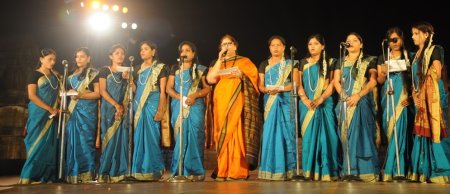 Utkal University of Culture 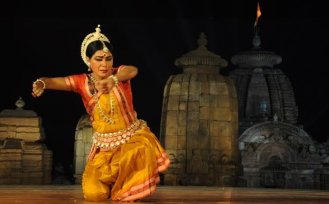 Aruna Mohanty Every evening in the beginning, the opening number was chorus singing by the local institutions. On the opening night, Utkal University of Culture presented Ravana's Shiva Tandava Stotra, since the temple's presiding deity is Lord Shiva, which set the mood. The solo performance by Aruna Mohanty stood out for her imaginative approach, individual choreography, understanding of the text and its flawless execution. She chose Rudramangalam depicting three forms of Shiva as Rudra, Mahakala and Nataraja. The various epithets of Rudra were danced suggestively evoking the iconic images. The images of Nirakara Om Kara and Mahakala created an impact. A seasoned dancer, Aruna handles the themes with maturity. Her well known choreographic work on Bhumisuta in collaboration with poet Kedar Mishra has been reviewed by me earlier. It is a moving tale of Sita who begs of her mother saying that in manasa, karmana and vachasa she has only thought of beloved Rama, and even then just because a washerman taunts his wife, casting aspersion on her fidelity and indicates Rama as a weakling, "I undergo such humiliation, Madhavidevi take me unto you." Aruna's portrayal was full of poignancy, at times heartrending, recalling main incidents of Sita's life, a lament, including the episode of her being pregnant and banished to the forest, sung so movingly by Rupak Kumar Parida that it left an indelible impression. The work is almost becoming a signature piece for Aruna in her repertoire. The duet by two disciples of Meera Das in form of a pallavi in Desh raga and rupaka tala explored the various facets of sculptural motifs with their youthful exuberance. I have seen individual performance of Puspa Panda and Lopamudra Jena in Gunjan Festival last year. Their training speaks well of Meera Das's painstaking efforts to groom the young generation. They danced with symmetrical movements, at times facing each other creating mirror images. With Darpani, Nupoor, Dhammil, playing various instruments, holding chibukamandana postures etc, they created a favourable impression. The song "Sajani lo, chanha, kete range kheluchhanti" had various sancharis including Kaliyadamana, Bakasuravadha, Rasalila, playing hori and so on, giving ample scope for two dancers to enact different characters. Choreographed to suit their duet by Meera Das, it was performed with joyous abandon. 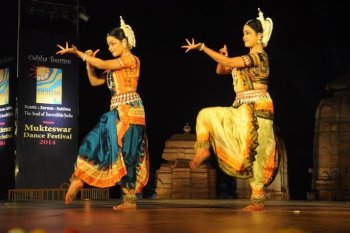 Puspa Panda and Lopamudra Jena 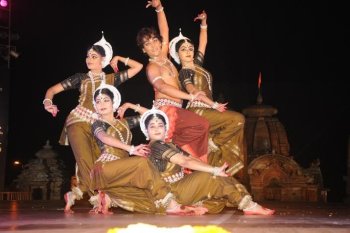 Nupur Anushthan The group performance by Nupur Anushthan choreographed by Niranjan Raut began with Shrimad Bhagavata shloka, Narayana Namskrutya. The seven dancers created impressive visuals performing Mangalacharan with arresting chauka position and created in round lotus patterns. In group dance it is easy to create images of gods and goddesses with multi arms. The image of Lord Vishnu astride Garuda and dancers exiting in a disciplined manner in one file looked very pleasant in terms of choreography. Khamaj pallavi with one male dancer in the centre with other female dancers was replete with various formations. The uniform tribhanga and chauka positions were maintained well. A competent team of musicians gave the group excellent support. Day two Beginning with chorus singing specially composed by Lakshmikant Palit, Mukteswara Vandana extolled Lord Shiva's greatness. A versatile music composer, Lakshmikant Palit has composed music for choral groups in16 languages. The group singing was melodious and built up the mood for the evening. 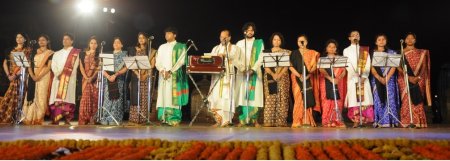 Lakshmikant Palit's group 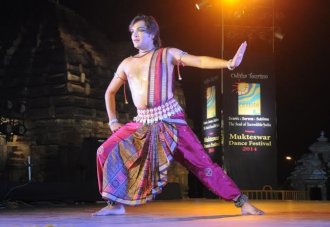 Saswat Joshi Saswat Joshi, a leading male dancer, has a star presence on stage. Trained at Odissi Research Centre, he has taken training under Ileana Citaristi and partnered her in many national and international festivals. As a solo dancer, he performed Rama Stuti written by Nityananda Mishra. Whereas his appearance, stance as Lord Rama were all impressive, the vocal support by the violin player was unfortunately unpleasant and sounded out of tune, thereby affecting the entire presentation and also the text. 'Karna' to the script by Dr P.K. Mishra dwelt upon Karna's plight when Kunti came to beg of him to spare her children who were his real brothers, in battle. Karna as a warrior was accepted by Duryodhana, but had suffered humiliations as a son of a charioteer, was cursed by Parashurama when in disguise as a Brahmin he went to learn dhanurvidya from him and at the time when the wheel of his chariot sank into the ground, Arjuna killed him against all norms of warfare. Indeed a poignant tale, it was well enacted by Saswat Joshi to choreography by Ileana Citaristi. There were melodramatic movements, which if restrained would invest the character of Karna with more dignity. The duet by Madhavi Mudgal's two disciples Shalakha Rai and Shobha Bisht had the deep impress of Madhavi's training along with Madhup Mudgal's music. After invocation, Pushpanjali followed by hymn to Lord Jagannatha, they presented Kalyan based Ragamalika pallavi to Talamalika. Both are well trained dancers and performed with professional ease, except that one of them looked very thin and often reminded viewers of Arushi Mudgal. The comparison indeed was odious, but inevitable. Both did justice to the complex patterns and intricate architecture of Odissi dance form. Banamali's Odiya pada "Path chhadi de" originally choreographed by Kelubabu to music by Bhubaneswar Mishra evoked nostalgia. Madhavi re-choreographed for the duet number. These works are gems of Odissi dance. Gopi's request to Krishna to let her go for puja, his turning the plate full of flowers, and gopi promising to return, were all performed with involvement. 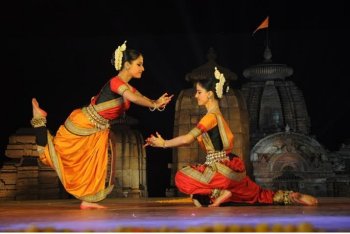 Shalakha Rai and Shobha Bisht 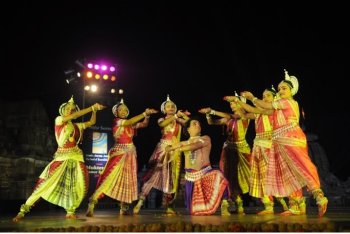 Tridhara group The group dance was presented by Guru Gajendra Panda under Tridhara established by Guru Deba Prasad Das. This is a precious legacy of Deba Prasad Das which Gajendra has been carrying on for a long time. However faithful Gajendra wants to remain to Deba Prasad's style, he needs to pay attention to movements which need sophistication and certain gravity. There are glimpses of group tableau; Shiva with Parvati on his left side, vama bhage, dancers creating backdrop and images etc, are visually striking. But overall impression is of restlessness. The prayoga of sabdaswarapata is a salient feature of Deba Prasad style. They are danced and recited as they need to be. What would help Gajendra when practicing, rehearsing and choreographing, is to have an outsider well versed in Odissi dance to offer feedback whereby the lacuna could be overcome. I have earlier seen Vajrakanti pallavi set to triputa tala. It has fascinating structure and in group choreography various arresting images. The melodic rhythm ta jhum ta ri ta jhenu has a haunting quality. The dancers including Gajendra's son need to pay attention to execution of movements to create an overall aesthetic appeal. I have no doubt that if Gajendra pays attention to these details, he would surely create wonders. The final number of Gananakayakapanchakam was embellished with sabdaswarapata, and as mentioned in the choreographer's note, had some typical movements of Chhau, Prahalad Nataka and Rasanritya. But to an uninitiated eye, they were not discernible. The image of Ganapati, his form, his tandava dance and the tableau moving with his vahana mushak had choreographic memories of Deba Prasad style. What all these works now need is certain refinement. As an inheritor of this precious legacy, I am confident Gajendra would do well. Day three The chorus singing by the group led by Keshaba Chandra Rout could have been different than one in raga Bhatiyari with Ravana's Tandava Stotra, as it looked repetitious. It is possible that they might have been asked to participate at a short notice. But this overlap should be avoided in future. This comment is no reflection upon their versatility. They did their job well. 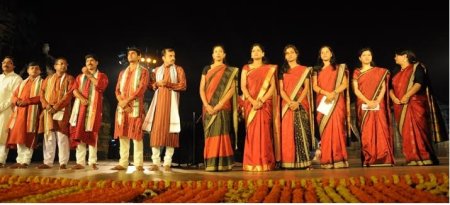 Keshaba Chandra Rout's group 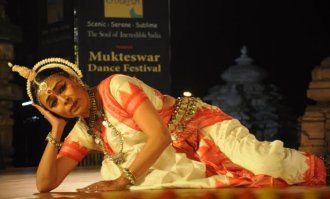 Jhelum Paranjape From Mumbai, dancer and guru Jhelum Paranjape with her solo displayed the timeless beauty of Guru Kelucharan Mohapatra's choreographic works. A celebrated dancer, she had the great luck to dance along with Guruji also. With true dedication, she carries on Kelubabu's legacy in Mumbai, performing, teaching and choreographing. She was ably assisted on mardala by Ratikant Mohapatra. She performed Shiva Upasana Stotram. It was full of devotional fervour. What was very moving was the rendering of ashtapadi "Dhira sameere Yamuna teere." Guru Kelubabu's choreography and Bhubaneswar Mishra's music have an eternal charm. Performing to that melodious music, Jhelum was in her element. Her abhinaya was restrained and dignified. Who can forget those memorable stanzas "patati patatre," bird sitting on the tree, and the leaves falling on ground, making Krishna look up for Radha arrival, or those exquisite sitting postures of sad Krishna. Sakhi telling Radha to put on a blue saree, leave ankle bells, Krishna preparing the bed with flowers... Ah!, those images are etched on one's memory and recalling them one relishes them more. Jhelum succeeded in evoking them. Duet by Guru Manoranjan Pradhan (trained by Guru Gangadhar Pradhan and also Kelubabu) along with his wife Minati Pradhan featured Nagendraharaya stuti and explored chaturbhuja form of Shiva, Shiva Parvati together, and glimpses of Madanabhasma prasanga. I wish there was more coordination in their presentation as both have good experience and long training under masters. Their enactment of Vichitra Ramayana to Sita's lament and episodes from Ramayana, Sita's kidnapping by Ravana, the refrain of Banagiri Latagiri, the flashback, Ravana's fight with Jatayu, his fall, Rama's blessings are well known. However, there were moments which looked overdramatic and reminded one of Jatra. These elements need to be curtailed and edited to raise the level of their presentation to aesthetic experience. 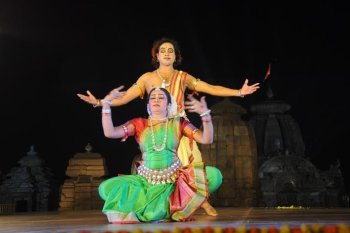 Manoranjan Pradhan & Minati Pradhan 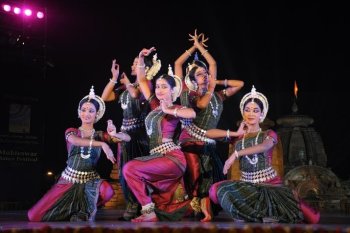 Srjan group The finale was the highlight of the entire Mukteswar Dance Festival. The group work of Srjan of Guru Kelubabu, looked after by Ratikant, stole the show. Ratikant as a guru and choreographer has raised the bar of aesthetic presentation in all departments. The training is uniform, the music is srutiranjan, pleasing to the ears, the aharya, costumes are pleasant and the overall sophistication places him in a class of his own. He has done Guru Kelucharan Mohapatra proud. The maturity is evident. All the three numbers presented had a uniform quality. Vande Mataram choreographed by Guruji and its treatment in the hands of Ratikant was praiseworthy. Set to Desh raga and adi tala, the stanzas showing images of Bharatamata in the poetic manner, sujalam, sufalam, the greenery, the flowers and fruits, the richness, the arches, trees, water, all the natural elements find felicitous expression. Dancers performing in circle and on one side, two dancers showing the national flag aflutter in wind with the hasta mudras were memorable visuals. Hamsadhwani pallavi in eka tala set to music by Bhubaneswar Mishra saw dancers in various formations, making parallel lines, diagonal rows, groups of two, one male one female, using space imaginatively, kaleidoscopic patterns resting on eyes with ease, forming square with four dancers in the centre and around them dancers moving in circle, bhramaris et al left lasting impression. The sound texture with dhage dhage dhage bols on pakhavaj and gathering of movements added to the enjoyment of the number. The final group choreography of Ardhanariswara saw Ratikant's imagination in full bloom. A challenge to create in group what Guruji had created as a solo for Sanjukta Panigrahi, a gem of a choreography, the memory of which is still green, Ratikant handled with confidence, mastery and grace. The description of Shiva and Parvati in Shankaracharya's marvellous upamas, similes, took exquisite forms in group as backdrops. For instance, the ornament as pannagabhushanaya, who is adorned with serpents, saw group of dancers in the background with sarpashira hastas, with raised arms like the hood of serpents and in front two dancers describing it while dancing. I can go on describing similar epithets but suffice it to say that the more one saw these subtleties, the more one admired Ratikant as a choreographer. In one sequence two dancers, one at the back covering the face of the dancer in front with palm suggesting half and moving displayed the ardhanari form, half male, half female. The group at the back like 'back up boys in a chorus' describes the adornments, distinct ornaments, clothes, stances of two - male and female, Shiva and Shakti in unusual choreography. Tandava and lasya are suggested in a seamless manner. What Natya Shastra often in Pindibandhas, choreographic references, mentions in terms of shrinkhala, chain, finds reflection in Ratikant's choreography. Prapanch shrishti words evoke samhara, turmoil and groups recreate that state. Ratnojjwalakundalaya, resplendent earrings, jagatjanani and other epithets add to the beauty of the presentation. In the end, one dancer seen seated with linga hasta mudra with closed eyes creates image that lingers long in mind. Several images overlap but there is a harmony in it which is a striking feature of Ratikant's choreography. All the dancers did justice to it. There were visuals reminiscent of pata paintings also as the groups fleeted from one sequence to another and at times just stood still at the back. Mukteswar Dance Festival ended on a very high aesthetic presentation. Seated next to me was senior Odissi dancer Dr. Priyambada Mohanty. She said with great assurance that seeing this presentation she was confident that the future of Odissi was safe. I think it sums up what these festivals aim at. The excellent, poetic commentary in Odiya by professional Mrityunjaya Rath is a sheer delight to listen to, whereas young dancer Sonali's accent still with American touch did not go well with Mrityunjaya's. She also needs to pay attention to Odiya words, which when not correctly announced cause rasabhanga, discordant note. The teamwork of all backstage artists led by Aruna Mohanty, the Vice Chairman of Odisha Sangeet Natak Akademi (OSNA), Chittaranjan Mallia, the secretary of OSNA and Odisha Tourism Dept and Sangeeta Gosain of Utkal University of Culture and others was praiseworthy.  Dr. Sunil Kothari is a dance historian, scholar, author and a renowned dance critic. He is Vice President of World Dance Alliance Asia Pacific India chapter, based in New Delhi. He is honored by the President of India with Padma Shri, Sangeet Natak Akademi award and Senior Critic Award from Dance Critics Association, NYC. He is a regular contributor to www.narthaki.com, the roving critic for monthly magazine Sruti and is a contributing editor of Nartanam for the past 12 years. Post your comments Pl provide your name and email id along with your comment. All appropriate comments posted with name and email id in the blog will also be featured in the site. |